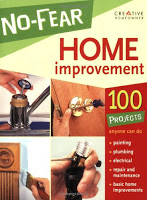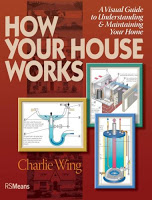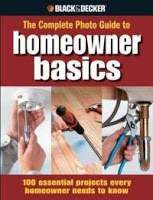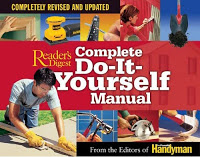 Dreaming about my future means also dreaming about a structure, typically a place where I might store my things and possibly feed / rest / bathe myself. Most people call these homes, but I’m still in the dreaming phase.
Dreaming about my future means also dreaming about a structure, typically a place where I might store my things and possibly feed / rest / bathe myself. Most people call these homes, but I’m still in the dreaming phase.
So it occurred to me I know next to nothing about home maintenance…what to do once I have a place of my own. I know slightly more about remodeling, like how paint goes on the wall and not the carpet. I know absolutely nothing about renovations, other than what I’ve seen on TV. From dream to nightmare!
The following represent some of the many DIY books we carry in the library. They share certain criteria; they are relatively current, they cover a range of topics, and is presented in a manner that is appropriate for an amateur.
 How Your House Works by Charlie Wing
How Your House Works by Charlie Wing
Technically, this isn’t a DIY book. Technically, this is a 3-D visual guide to the ins and outs of your average home. It shows the parts and processes of every typical appliance, device, or system. For example, full-page graphics illustrate 25 air-control systems, another 30 for plumbing and plumbing related. The benefit of 3D models is clarity, removing distracting background details.
Consider this a tourist map to your home. Properly naming a broken part is helpful to store clerks and repairmen alike.
 The Complete Photo Guide to Homeowner Basics; The Complete Photo Guide to Home Repair from Black and Decker
The Complete Photo Guide to Homeowner Basics; The Complete Photo Guide to Home Repair from Black and Decker
Black and Decker is a household name when it comes to tools and DIY. These two titles suit the company’s style. Photographs are used like in Wing’s guide. Each chapter opens with an overview of the subject (plumbing, flooring, etc) and a visual guide to it. Each project comes with a photo guide for the required tools and supplies. As someone who triple checks the instructions, especially in the middle of a task, quick visual aids definitely useful.
As well as the visual aids, these guides identify the skill sets required, the difficultly level, and the task-specific terms. This means if you don’t get it, you shouldn’t do it!
I need more warning labels like that…
The key difference between these two titles is the extent of the projects. Homeowner Basics cover items you should monitor. Home Repair tackles more complex or in-depth topics. This includes security options, safety issues like childproofing and fire codes, and health concerns such as mold, radon, and carbon monoxide. Home Repair also provides handy reference charts of tools, fasteners, supplies and conversions, and several other useful resources.
Similar titles from household names include:
* No-Fear Home Improvement from Creative Homeowner – a great introductory guidebook
* Ultimate Guide to Home Repair and Improvement from Creative Homeowner – for the experienced and the gutsy
* Complete Home Improvement and Repair from Lowe’s – what better than a guide from an a chain of home-improvement stores
* DIY to the Rescue by Karl Champley & Amy Devers – based on the show of the same name, from the DIY network
 Reader’s Digest Complete Do-It-Yourself Manual (with the editors of the Family Handyman)
Reader’s Digest Complete Do-It-Yourself Manual (with the editors of the Family Handyman)
I love these Reader’s Digest instruction books. Wider pages offer more display options, and these books use them to their fullest. A variety of illustration types are found in this book. Photos, sketches, 3D models and line drawings are used when most appropriate to the subject…whatever is clearest. I think this is the most thorough of the guides, but its American-centric references are not as useful as…
 Do It Yourself; DIY Quick Fix by Julian Cassell et al, from Doring Kindersley
Do It Yourself; DIY Quick Fix by Julian Cassell et al, from Doring Kindersley
I would place these titles on par with the Reader’s Digest, in terms of scope. But the projects aren’t what make these guides so good. Do It Yourself provides an amazing, photographic equipment list, but what else would you expect from DK? It examines and describes types of hand tools, types of power tools, high-end rental tools, measuring devices and conversions, landscaping gear, materials, supplies and textiles and more.
 DIY Quick Fix is a coil bound flip book, supplementary to Do It Yourself. With handy tabs for quick searches, this book claims to have fixes for 100 common problems. A column on the right hand indicates the subject, and all the projects listed within. This includes the kitchen and bathroom, interior decor, the outdoors, electrics and plumbing, and alteration and repairs. If you’re ever in a bind, this would be a great title to keep near your tool box.
DIY Quick Fix is a coil bound flip book, supplementary to Do It Yourself. With handy tabs for quick searches, this book claims to have fixes for 100 common problems. A column on the right hand indicates the subject, and all the projects listed within. This includes the kitchen and bathroom, interior decor, the outdoors, electrics and plumbing, and alteration and repairs. If you’re ever in a bind, this would be a great title to keep near your tool box.
Oh, and both are Canadian-centric!
 When Duct Tape Just Isn’t Enough by C.J. Petersen
When Duct Tape Just Isn’t Enough by C.J. Petersen
Published by Popular Mechanics, this is another coil-bound flipbook, colour-coded and full of advice. This guide is focused on the everyday problems, including topics slightly off the home maintenance track, like how to patch an air-mattress, or how to open a rusted lock, or how to refurbish your furniture. I enjoy the disaster prevention tips placed throughout. It discusses types of paint, how to work safely on the roof, when to fix or ditch an appliance, even the joys of pool maintenance…the kinds of questions that need asking, but may not have come to mind.
_____________________________________________________________________________________
 I hesitantly present this as a side note. I, for one, try not to think of tasks in terms of gender. But there are cookbooks for men (for example: The guy can’t cook : over 350 fantastic no-fail recipes a guy can’t be without by Cinda Cavich). There so too are there DIY books for women. Here’s two that stuck out for me:
I hesitantly present this as a side note. I, for one, try not to think of tasks in terms of gender. But there are cookbooks for men (for example: The guy can’t cook : over 350 fantastic no-fail recipes a guy can’t be without by Cinda Cavich). There so too are there DIY books for women. Here’s two that stuck out for me:
Do It Herself by Joanne Liebeler
This is as much a beautification guide as a repair guide. On top of the expected topics, it covers emergency preparedness, key tools for your home, a great seasonal maintenance chart, and a less-often discussed pest-control guide. Chix Can Fix by Norma Vally (of Discovery Home Channel’s Toolbelt Diva)
Chix Can Fix by Norma Vally (of Discovery Home Channel’s Toolbelt Diva)
Her realistic voice and familiar anecdotes introduce the many DIY topics, and how such disasters can happen to anyone, at anytime. This is a great title for a nervous newbie.
Source: http://www.thereader.ca/2011/05/diy-for-home-owners.html


